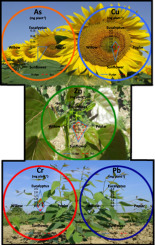Environmental Research ( IF 8.3 ) Pub Date : 2018-03-20 , DOI: 10.1016/j.envres.2018.03.009 Werther Guidi Nissim , Alessandra Cincinelli , Tania Martellini , Laura Alvisi , Emily Palm , Stefano Mancuso , Elisa Azzarello

|
Phytoremediation is a green technique being increasingly used worldwide for various purposes including the treatment of municipal sewage sludge (MSS). Most plants proposed for this technique have high nutrient demands, and fertilization is often required to maintain soil fertility and nutrient balance while remediating the substrate. In this context, MSS could be a valuable source of nutrients (especially N and P) and water for plant growth. The aim of this study was to determine the capacity willow (Salix matsudana, cv Levante), poplar (Populus deltoides × Populus nigra, cv Orion), eucalyptus (Eucalyptus camaldulensis) and sunflower (Helianthus annuus) to clean MSS, which is slightly contaminated by trace elements (TEs) and organic pollutants, and to assess their physiological response to this medium. In particular, we aimed to evaluate the TE accumulation by different species as well as the decrease of TEs and organic pollutants in the sludge after one cropping cycle and the effect of MSS on plant growth and physiology. Since MSS did not show any detrimental effect on the biomass yield of any of the species tested, it was found to be a suitable growing medium for these species. TE phytoextraction rates depended on the species, with eucalyptus showing the highest accumulation for Cr, whereas sunflower exhibited the best performance for As, Cu and Zn. At the end of the trial, some TEs (i.e. Cr, Pb and Zn), n-alkanes and PCBs showed a significant concentration decrease in the sludge for all tested species. The highest Cr decrease was observed in pots with eucalyptus (57.4%) and sunflower (53.4%), whereas sunflower showed the highest Cu decrease (44.2%), followed by eucalyptus (41.2%), poplar (16.2%) and willow (14%). A significant decrease (41.1%) of Pb in the eucalyptus was observed. Zn showed a high decrease rate with sunflower (59.5%) and poplar (52%) and to a lesser degree with willow (35.3%) and eucalyptus (25.4%). The highest decrease in n-alkanes concentration in the sludge was found in willow (98.3%) and sunflower (97.3%), whereas eucalyptus has the lowest PCBs concentration (91.8%) in the sludge compared to the beginning of the trial. These results suggest new strategies (e.g. crop rotation and intercropping) to be adopted for a better management of this phytotechnology.
中文翻译:

微量元素和有机化合物污染的污水污泥的植物修复
植物修复是一种绿色技术,在世界范围内越来越多地用于各种目的,包括处理市政污水污泥(MSS)。为此技术提出的大多数植物对养分的需求很高,在修复基质时通常需要施肥以保持土壤肥力和养分平衡。在这种情况下,MSS可能是植物生长所需的养分(尤其是氮和磷)和水的宝贵来源。这项研究的目的是确定柳树(Salix matsudana,cv Levante),杨树(Populus deltoides×Populus nigra,cv Orion),桉树(Eucalyptus camaldulensis)和向日葵(Helianthus annuus)清洁MSS的能力,MSS受到轻微污染。通过微量元素(TEs)和有机污染物,并评估它们对该介质的生理反应。尤其是,我们的目的是评估一个种植周期后不同物种的TE积累以及污泥中TEs和有机污染物的减少,以及MSS对植物生长和生理的影响。由于MSS对任何测试物种的生物量产量均未显示任何有害影响,因此发现它是这些物种的合适生长培养基。TE的植物提取率取决于物种,桉树对Cr的积累最高,而向日葵对As,Cu和Zn的表现最好。在试验结束时,对于所有被测物种,某些TEs(即Cr,Pb和Zn),正构烷烃和PCBs的污泥浓度均显着降低。在装有桉树(57.4%)和向日葵(53.4%)的花盆中观察到最高的Cr降低,而向日葵显示的Cu降低最高(44.2%),其次是桉树(41.2%),杨树(16.2%)和柳树(14%)。观察到桉树中Pb显着降低(41.1%)。锌在向日葵(59.5%)和白杨(52%)上的减少率很高,而在柳树(35.3%)和桉树(25.4%)上的减少程度较小。与试验开始相比,柳树中的正构烷烃浓度下降幅度最大(98.3%),向日葵中的正构烷烃浓度下降幅度最大(97.3%),而桉树中的PCBs最低(91.8%)。这些结果表明将采用新的策略(例如轮作和间作)以更好地管理这种植物技术。5%)和杨树(52%),而柳树(35.3%)和桉树(25.4%)则较少。与试验开始相比,柳树(98.3%)和向日葵(97.3%)的污泥中正构烷烃浓度下降幅度最大,而桉树中PCBs的最低浓度(91.8%)。这些结果表明将采用新的策略(例如轮作和间作)以更好地管理这种植物技术。5%)和杨树(52%),而柳树(35.3%)和桉树(25.4%)则较少。与试验开始相比,柳树(98.3%)和向日葵(97.3%)的污泥中正构烷烃浓度下降幅度最大,而桉树中PCBs的最低浓度(91.8%)。这些结果表明将采用新的策略(例如轮作和间作)以更好地管理这种植物技术。



























 京公网安备 11010802027423号
京公网安备 11010802027423号